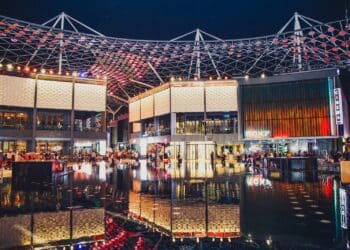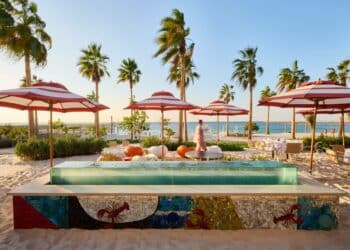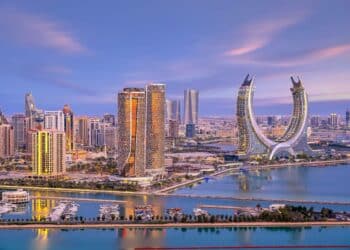Terror attacks and regional conflicts have seen the once bustling shorelines of Tunisia dwindle as visitor numbers plummeted to an all-time low at the start of 2016, but the North African tourism hub is refusing to go down without a fight. As new new government incentives and the 3+1 Tourism Vision unravel to bolster the hospitality sector, Hotel News ME uncovers how the country is working to secure big hotel brands and reinvent its holiday scene as not just a quick package deal, but as a 5-star haven too. 
In the years leading up to 2011, Tunisia was a popular destination for many European holidaymakers in search of a nearby, safe and affordable sun and sea destination. For more than 40 years, Tunisia’s resorts in beachside cities like Sousse and Hammamet had catered to a primarily package tourist crowd, attracting visitors from France, Germany, Italy and the UK. The country’s attractions are unique – from the ksours (castles) of Tataouine to the beaches of Djerba to the ruins of Carthage – however, recent years have proven challenging. The 2011 revolution led to a drop in visitor numbers in the immediate aftermath in turn exacerbating structural issues, such as a lack of diversified offerings. This was further impacted by a pair of terrorist incidents in 2015, which slowed the pace of the industry’s recovery from the 2011 revolution. However, while the short-term outlook is somewhat uncertain, the efforts adopted by the government under Vision 3+1, provide cause for optimism in the medium to long term. The ability of the sector to diversify its offerings and provide a wider selection of accommodation and activities should help buffer revenues in the future and ensure a more sustainable growth trajectory.
Visitor numbers
Since the country’s formal independence from France in 1956, Europeans have formed the bulk of foreign visitors, visiting the country primarily for its favourable weather, sandy beaches, affordability and proximity to Europe. In total, out of the 6.9m visitors who went to Tunisia in 2010, more than 50% were European. By 2014, the overall volume of visitors had recovered significantly – from a low of 4.8m in 2011, to 6m. However, as a result of the security incidents in March and June 2015, by November 2015, visitor numbers stood at 4.9m, according to data from the Ministry of Tourism. While the majority of the country’s visitors have traditionally been European, a large proportion come from neighbouring Algeria and Libya. In 2010, at the height of the pre-2011 revolutionary era, 3.8m Europeans came to Tunisia with the largest group being from France, at 1.3m visitors, followed by Germany with 458,631 visitors, Italy with 354,127 visitors and the UK with 353,282 visitors. In the two years that followed the revolution however, the landscape of the industry was an entirely different one as dips in certain source markets were offset and new ones started to emerge. While losses were registered in the country’s traditional markets, the number of visitors from Eastern Europe significantly increased, with arrivals in 2012 from Russia, Ukraine and the Czech Republic increasing respectively by 33%, 66% and 10%, over 2010. This trend was reversed in the two years that followed, with arrivals from traditional markets gradually recovering and those from Eastern Europe and Russia, falling on the back of the Ukrainian conflict and the drop in the value of the Rouble.
Vision 3+1
To help better buffer the sector from the turbulence of recent years, and to improve its prospects for the long-term, Tunisia introduced a new sectoral development strategy, Vision 3+1 in 2014. The strategy comprises four central pillars: product diversification in line with regional specificities; quality and training; promotion; and sector modernisation. Its ultimate goal is to develop better quality and allow for a more sustainable form of tourism to emerge. The objectives outlined under this strategy are expected to be achieved within the next seven to 10 years with TD1.5m allocated in 2015 to fund up to 60% of the 40 reform plans announced under Vision 3+1. More funds, however, will need to be mobilised, notably through public-private partnerships and foreign collaboration, to allow the full package of reforms to come to fruition.
Key among the reforms outlined in the tourism strategy is the restructuring of the Tunisian National Office for Tourism, a public entity overseen by the Ministry of Tourism and previously responsible for regulating and developing the sector, human resource training and promotion. The restructuring will maintain the National Office’s focus on promotion and training, but also give it a mandate to attract investment, with each objective delegated to a separate entity. Nevertheless, according to Mohamed Essayem, regional commissioner of the ONTT in Kebili, the results of this won’t become apparent for another five to 10 years. Foreign representations of the ONTT abroad are also expected to be restructured under the government’s reform plan, with the goal of reinforcing their role in promoting the destination.
Hotel debt
The government’s efforts are crucial not only to helping navigate the short-term instability but also to ensuring the long-term success of the sector. While the events of 2015 and the post-revolution era more generally have created challenges, the government is also looking to address more fundamental constraints, such as financial sustainability. Tunisia has traditionally built its tourism industry on package tours, which rely heavily on affordability as a means of attracting visitors. The emphasis on the all-inclusive low-cost beach package, along with high levels of competition both within the country and from nearby destinations like Turkey, have meant that while a holiday in Tunisia is within reach of many, margins can be tight.
Revenues have dwindled, service quality has decreased and hoteliers struggled to meet their financial obligations, a situation that predates the revolution. Today, the sector’s overall estimated debt amounts to over TD 3bn. This has had an impact on the sustainability of the sector, with the situation further affected by the events of 2015. According to statistics put together by the Professional Association for Tourism, 270 hotels out of the country’s 570 classified hotels had closed their doors as of December 2015. Regions where more than half of hotels were closed include Mahdia at 71%, the south at 64%, Monastir at 62%, Djerba-Zarzis at 58% and Cap Bon at 58%. As a result, the authorities have adopted emergency measures in a bid to avoid the situation from deteriorating any further. Previous efforts – which have included a potential state-run debt management agency focused on the hotel sector, as well as debt recovery agencies – have yielded minimal results, in part due to the change in governments.
However, as of last year, the government announced that all debt related to 2015 and 2016 would be postponed and rescheduled in line with each establishment’s capacity to pay off arrears. Government-backed loans, refundable over a seven-year period, will be granted to hoteliers to finance their activities through to the end of 2016, and value-added tax has been brought down from 12% to 8%.
Diversification
The Vision 3+1 strategy will help address another structural constraint: the lack of diversified hospitality offerings. Following a template rolled out in the 1960s and similar to initiatives in Spain during the same era, most of Tunisia’s hotels have been crammed into what are known as tourism zones along the coast, in areas such as Djerba, Hammamet, Sousse, Monastir and Mahdia.
The most recently constructed zone, Yasmine Hammamet, was established at the end of the 1990s. Spread over 278 km with 4 km of coastline, the zone boasts more than 50 4- and-5-star hotels with a bed capacity of 30,000. However, the zone’s location is far from any city centre and with the traditional offerings of integrated facilities and activities, largely confines tourists to the resorts. This design has left the zone’s accommodations reliant on their appeal to package tourists, as opposed to other visitors who might be interested in less traditional vacations. The location of these zones and their all-inclusive nature, has had minimal impact on business growth in the surrounding area.
There is certainly no shortage of ways in which Tunisia can diversify its tourism offerings. The country is hugely appealing to visitors in many different ways. Existing alternative offerings include Saharan tourism; business and meetings incentives conferences and exhibitions; health and wellness; and golf tourism. However, most remain shy of their potential mainly due to inadequate infrastructure or simply poor product development. Today, Tunisia is more eager than ever to diversify and develop alternative year-round offerings to boost value added and sector profitability, and attract new flows of tourists. A staunch supporter of product diversification is the newly established GPT. Founded in February 2015, the GPT is part of the Confederation of Tunisian Citizen Enterprises, a trade union, and aims at contributing to the diversification of Tunisian tourism offerings via public-private partnerships. To that end, the organisation has put forth 12 products for development. These include traditional niche segments, such as health and wellness and business tourism but also new offerings such as nautical, senior and adventure offerings.
Hospitality infrastructure
The drive to diversify tourism offerings has been accompanied by new forms of hospitality infrastructure in recent years. In a break with the large-scale beach resorts of the past, a number of high-end, small-range accommodation offerings – such as guesthouses, boutique hotels and rural lodgings – have popped up in both the coastal and interior areas of the country.
One of the most visible aspects of this has been the creation of a new industry group, Dar Tunisia, in 2012. Comprised of 12 independent operators in the hospitality sector, the association aims to represent and promote high-end accommodation available along the coast, but also in remote areas of the country such as Tamerza, a mountain oasis in the south-west, and Timbaine, in the heart of the Tunisian desert. Among the venues that are comprising this new segment include Villa Bleue in Sidi Bou Said, Palais Bayram in the medina of Tunis, Dar Sabri in Nabeul, Dar Dhiafa Erriadh in Djerba, Dar Nejma in Tozeur and Dar Hi in Nefta.
Big brands
In August 2014, Qatari-based group La Cigale inaugurated its first 5-star 248 room hotel in Tunisia in the north-west town for Tabarka, followed in December 2014 by La Badira. The hotel belongs to the US-based consortium for luxury hotels, the Leading Hotels of the World, and opened a 120-room hotel in Hammamet.
More recently, in May 2015, Hilton concluded a franchise agreement with Tunisian El Mouradi Hotels and Resorts group to takeover management at the Hotel Africa in Tunis as well as refurbish it. The hotel will be rebranded DoubleTree by Hilton Tunis-Africa and undergo renovations worth $5m to refurbish the hotel’s 212 rooms and related facilities. This was followed by an announcement in July 2015 that hotel Iberostar Diar El Andalous in Sousse had opened its doors again after years of refurbishment, which saw it converted into a 5-star property with 370 rooms.
Located largely in the capital city of Tunis and catering primarily to a combination of high-end and business clientele, a number of other international chains are also present in the country, including Mövenpick, Golden Tulip, Sheraton, AccorHotel Group, Concorde Hotels and Resorts, and The Residence. With the exception of Accor’s two hotels – which opened in February 2012 – most of these brands were present in Tunisia prior to the 2011 revolution, and despite the fragile transition that ensued, most have maintained their operations.
Existing brands are also looking to expand their presence across the country. Mövenpick is expected to open a new hotel in 2017 in Tunisa’s high-end neighbourhood of Les Berges du Lac. The Residence is expanding to the Medina of Tunis – a UNESCO World Heritage site since 1979 – with a new 4-star boutique hotel. Finally, Qatari-based group La Cigale acquired its second hotel – previously known as Dar Naouar – in Gammarth in 2015 for a total $8.3m.
Looking ahead
Although 2015 was challenging for the tourism sector, and this slowed the pace of the industry’s recovery from the 2011 revolution, although the short-term outlook is somewhat uncertain, the efforts adopted by the government under Vision 3+1, provide cause for optimism in the medium to long term. The ability of the sector to diversify its offerings and provide a wider selection of accommodation and activities should help buffer revenues in the future and ensure a more sustainable growth trajectory.


































































